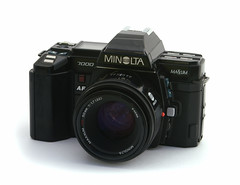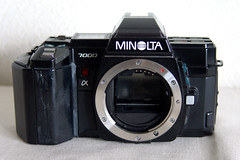Minolta 7000
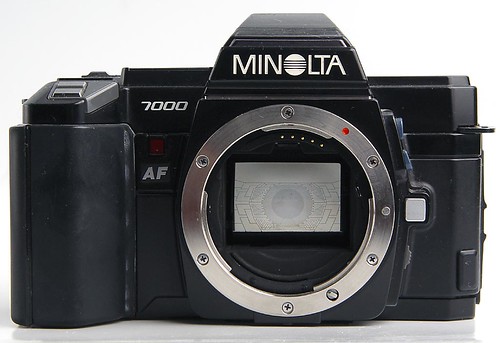
|
| 7000 AF image by Martin Taylor (Image rights) |
The Minolta 7000 AF was the first popular autofocus SLR camera. Known as the Maxxum 7000 in North America and α-7000 (Alpha 7000) in Japan.
Before the Minolta 7000, Nikon, Canon, Pentax and Olympus had experimented with self-contained auto-focusing lenses that worked with their existing cameras and used their existing lens mounts. In 1983 the Minolta 7000 was preceeded by Nikon's professional 35mm SLR Nikon F3AF with built-in through-the-lens contrast focus detection[1]. Minolta burst onto the scene in 1985 with their own in-body auto-focus camera system and changed the SLR camera market forever by having made the technology affordable for photography amateurs. In rapid succession the company released three cameras (5000, 7000 and 9000) and dozens of lenses and accessories to make a completely new fully featured AF system. For the next couple of years Minolta autofocus film cameras dominated the market.
This was not just a manual focus camera with autofocus added. It was truly a revolutionary camera in that it redefined what an SLR was with the addition of computer chips in the camera body, lenses, and accessories. These controlled the camera functions for optimal results. For example, when a lens was mounted, its ROM chip would access the camera's CPU to optimize the program for that lens, and on-camera flash heads zoomed automatically with changes in focal length. This level of sophistication had not previously been brought to market. A built in motor drive and other automated features set the standard for other manufacturers.
In addition to autofocus, the Maxxum had manual, aperture priority, shutter priority, and program modes. Knobs and dials were replaced with pushbuttons and internal and external liquid crystal displays (LCD's). Popular with many new buyers, the LCD displays were disliked by some photographers used to the older controls, which lead to the pro version of the camera, the 9000, relying on more mechanical controls. The new camera body utilized a large amount of plastic composites which also came in for both praise and criticism. Minolta had a history of not disguising its plastic construction as had other manufacturers (for example the popular x-700). 7000's were durable cameras.
The kit lens for the camera was a 35-70mm f4 Minolta AF lens with macro switch. Its zoom setting ring served in macro mode as manual focusing ring.
| ||
|
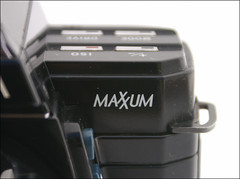
|
| early Maxxum logo image by Steve Harwood (Image rights) |
Early Maxxum 7000 cameras were inscribed "MAXXUM 7000" with a crossed 'XX'. The oil company Exxon considered this a violation of their trademark, as the XX in their logo was linked in a similar fashion. As a result, Minolta was allowed to distribute cameras already produced, but was forced to change the stylistic XX in Maxxum and implement this as a change in new production. All Maxxum cameras to this day have had regularly scripted 'X'.
Unfortunately for Minolta, its autofocus design was found to infringe on the patents of Honeywell, a U.S. corporation. After protracted litigation, Minolta in 1991 was ordered to pay Honeywell damages, penalties, trial costs, and other expenses in a final amount of 127.6 million dollars.[2]
When Pentax and Nikon entered the autofocus segment, both utilized a similar passive array AF system as Minolta, but decided to retain compatibility with their existing manual-focus K and F mounts respectively. Canon, like Minolta, chose to change their mount completely, introducing the EOS 600-series a few years later, breaking the compatibility with the former FL and FD lens mounts. Like Canon, Minolta's decision to orphan its manual-focus mount cost it the support of some loyal customers, but in so doing, it also gained some new customers.

|
| Maxxum 7000 (late) image by Daniel Gjakoni (Image rights) |
In 1987 Minolta presented another pioneering product, the video CCD camera back SB-70 to convert the camera into a 307.000 Pixel still camera based on analog video electronics. The camera back wrote its image data onto special 2" floppy disks. The camera back worked with a VHS-like analog imaging and recording technology, with a small crop factor 2 video CCD chip. One disk could store 25 or 50 images, depending on the chosen image quality.[3]
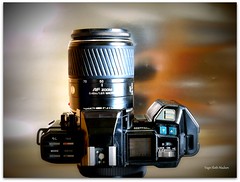
|
| top view image by Vagn Sloth-Madsen (Image rights) |
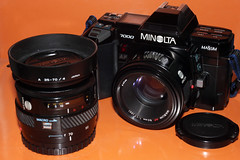
|
| image by Wayne Young (Image rights) |
References
- ↑ Nikon F3AF, presented in 1983 together with a portait AF Nikkor lens and a tele AF Nikkor lens, see Modern Classic SLRs: Nikon F3AF
- ↑ Article, "Minolta Credit Rating Downgraded by Moody's", July 11, 1992, NY Times
- ↑ SB-70/SB-90 camera back data at M. Hohner's
Links
- Minolta Maxxum 7000 and Maxxum (Dynax) 7000i reviews in Modern Classics section of Photography in Malaysia.
- Minolta 7000 Review by James H Coleman (Australian Photography May 1985) on The Minolta Users Group
- Minolta 7000 in Sylvain Halgand's collection (in French).
- Minolta Maxxum 7000 listed at number 8 in Jason Schneider's Top 20 Cameras Of All-Time on Shutterbug. Posted 2008.
- data of kit lens 35-70 f4 at Michael Hohner's, with link to Kurt Munger's lens review,
| Minolta Classic Cameras |
|---|
| Vest (or Best) | V2 | SR-2 | SRT 101 | XE | XD | CLE | 7000 | 9000 | 800 si |
| Japan Camera Grand Prix | |
|---|---|
| Camera of the year
1984: Nikon FA | 1985: Minolta α-7000 | 1986: Canon T90 | 1987: Canon EOS 650 | 1988: Kyocera Samurai | 1989: Nikon F4 | 1990: Canon EOS 10 | 1991: Contax RTS III | 1992: Pentax Z-1 | 1993: Canon EOS 5 | 1994: Minolta α-707si | 1995: Contax G1 | 1996: Minolta TC-1 | 1997: Nikon F5 | 1998: Pentax 645N | 1999: Minolta α-9 | 2000: Canon EOS-1V | 2001: Minolta α-7 | 2002: Canon EOS-1D | 2003: Canon EOS-1Ds | 2004: Nikon D70 | 2005: Konica Minolta α-7 Digital | 2006: Nikon D200 | 2007: Pentax K10D | 2008: Nikon D3 | 2009: Canon EOS 5D Mark II | 2010: Olympus Pen E-P1 | 2011: Pentax 645D | 2012: Nikon D800 | 2013: Sony DSC-RX1 | 2014: Nikon Df | 2015: Canon EOS 7D Mark II | 2016: Sony α7R II | 2017: Olympus OM-D E-M1 Mark II | 2018: Sony α9 | 2019: Lumix S1R | 2020: Sony α7R IV | 2021: Sony α1 | 2022: Nikon Z9 | 2023: Sony α7R V Special Prize Editor | |
